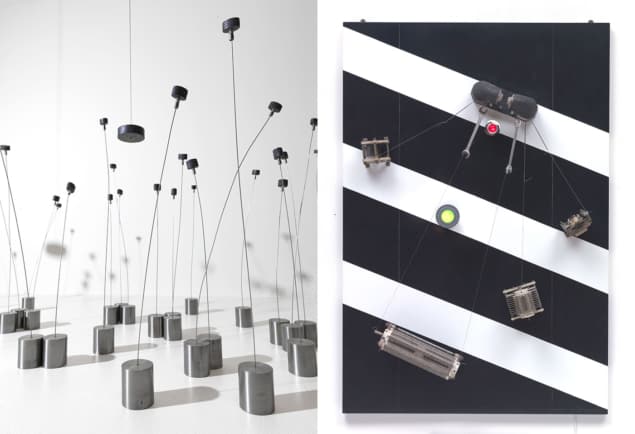Metal and magnetism; light and darkness; as well as sound and silence all come into play at the Takis exhibition at the Tate Modern, as Rachel Brazil discovers

Pioneering artist Panagiotis Vassilakis (1925–2019), known professionally as Takis, spanned the divide between art and science, breaking conventions with his “kinetic” sculpture that used electromagnetism to explore the concept of energy. Born in Athens in 1925, Takis moved to Paris in 1954 and became a key figure of the avant-garde in Paris, London and New York. The renowned Signals London gallery was named after his influential series of antennae-like sculptures, and became an important hub for the transmission of ideas and the dissolution of barriers between the arts and sciences.
From July to October this year, 70 of Takis’ major works are on display at the Tate Modern gallery in London, a fitting tribute to the recently deceased artist who sought to communicate the poetry and beauty of the electromagnetic universe. The exhibition, simply titled Takis, was co-curated by writer and curator Guy Brett, who was closely involved in Signals London, together with the Tate’s international art curator Michael Wellen and assistant curator Helen O’Malley.
Takis became fascinated by electromagnetism in 1959, describing it as “an infinite, invisible thing, that doesn’t belong to earth alone. It is cosmic; but it can be channelled”. An early work of his – Oscillating Parallel Line / Ligne parallele vibrative (1965) – involved suspending a needle in air using a powerful magnet, to highlight how magnetism can override the laws of gravity. “I would like to render [electromagnetism] visible so as to communicate its existence and make its importance known; I would like to make visible this invisible, colourless, non-sensual, naked world which cannot irritate our eye, taste or sex. Which is simply pure thought.” The artist was never too focused on the “visual qualities” of his work, saying instead that “what I was obsessed with was the concept of energy”.
Despite covering a lifetime of his work, the Tate exhibition is not chronological. Instead it is thematically arranged, with rooms dedicated to the themes of magnetism and metal, light and darkness, and sound and silence, all using elements of electromagnetism to dramatic effect. Takis dubbed his magnetism-inspired works “telemagnetic” and these mostly use magnetic fields to suspend metal objects in space, appearing to float as if defying gravity. He was interested in the gaps between the floating objects where “energy” clearly existed but there was nothing to see or touch. A highlight of the exhibition is Magnetic Fields (1969), where magnetic pendulums trigger movement from nearly 100 sculptures. On loan from the Guggenheim Museum, this is being displayed for the first time since the 1970s.

In the light and darkness section, displayed in a darkened gallery, several works are made with glowing blue mercury-arc rectifiers, such as Télélumière No. 4 (1963–1964). These glass bulb valves, containing a pool of mercury, were once commonly used for converting high-voltage or high-current alternating current (AC) into direct current (DC). The arc between the mercury pool and multiple metal anodes only allows current to pass in one direction. The rectifier is switched using an electrode, which can be dipped into the mercury pool using an external electromagnet, causing a spark to ionize the mercury vapour and initiate the arc.
These components were usually hidden from view in power substations or railway controls, but Takis saw their beauty. “Seeing them turn on is a really incredible experience,” says O’Malley. “The gas turns a really extraordinary kind of aqua blue colour, but it’s a really slow build, until it reaches full brightness.” The Tate set these works to switch on and off in 15-minute increments and it’s worth the wait.
These works have a distinctly post-war pre-transistor feel. Takis sourced many of his materials from military surplus shops and flea markets, salvaging radio antennas and control dials from US army Jeeps or aeroplanes. As with his art, his electronics skills were self-taught. “When you see the back of a lot of the artwork, the wiring and the electrics is total chaos. You can tell that it was constructed by an amateur,” adds O’Malley.
The final section of the exhibition concentrates on sound and the acoustic devices Takis created, which are part kinetic sculpture, part musical instrument. In the exhibited sequence of his Musicals, an electromagnet is switched on and off to make a needle bounce against a stretched and amplified wire, giving out the sound of a single prolonged note that starts and stops as the needle hits and drops away from the wire. Perhaps with his Greek heritage in mind, Takis was interested in the mystical ideas of Pythagoras and the concept of the music of the spheres – the idea that mathematical relationships express qualities of energy, manifested in numbers, angles, shapes and sounds. The somewhat jarring sounds he created will not be to everyone’s taste though. “Being surrounded by eight or nine of those works is actually a really intense experience that some people love, and others hate, finding it really uncomfortable,” says O’Malley.
The works displayed in this exhibition demonstrate how art can illuminate scientific concepts, and most physicists will understand the feeling of awe his sculptures generate. Takis himself clearly had the spirit of an experimentalist. “You hear anecdotes about explosions, and of combining materials and then running behind the couch because he was nervous something might happen,” says O’Malley.
He also worked with scientists and engineers during a fellowship at MIT in 1968, where together with engineer Ain Sonin, he invented a floating wheel to harness wave energy. The “sea oscillation” device was tested in Boston harbour in 1968 and could generate 1–6 W of power. Perhaps once displaying symbols of the scientific cutting edge, these works now provide a beautiful showcase of technology from a past era and a chance to rethink our own relationship to the electromagnetic universe.
-
Takis is open 3 July – 27 October 2019. Co-curated by Guy Brett, Michael Wellen and Helen O’Malley. The exhibition is organized by Tate Modern in collaboration with the MACBA Museu d’Art Contemporani de Barcelona and the Museum of Cycladic Art, Athens



